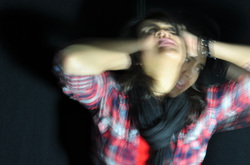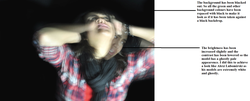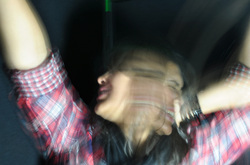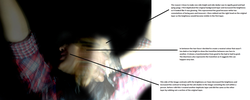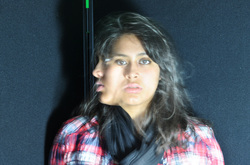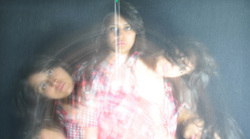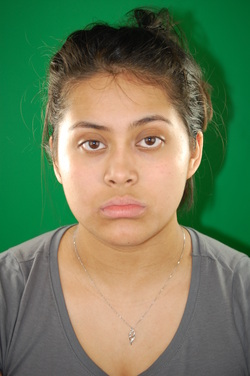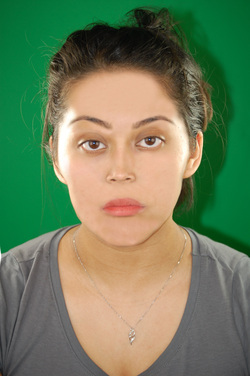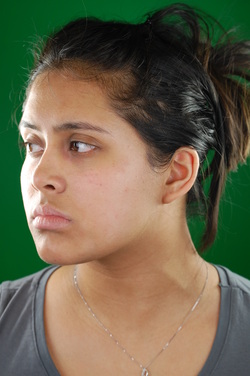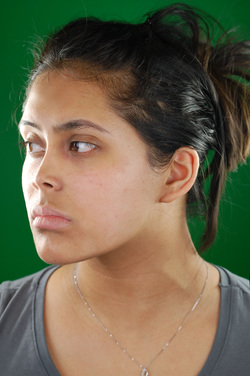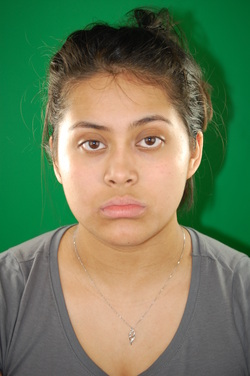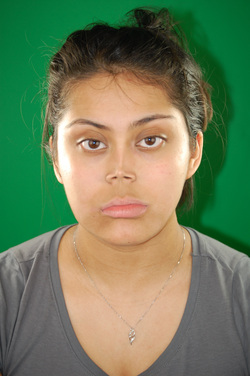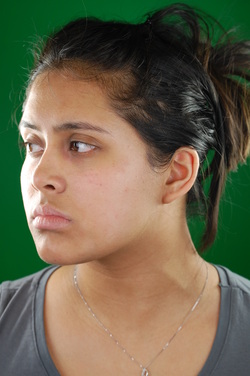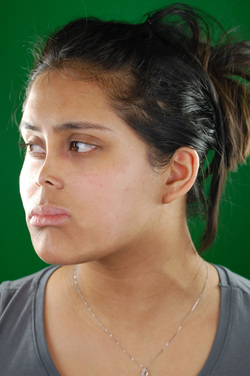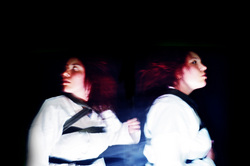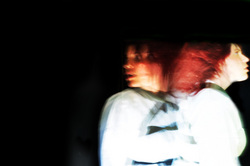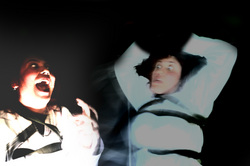Exploration & Discovery: Being Human
Introduction
My exam topic is 'Exploration & Discovery' and to help me start my exam I first read and annotated the exam paper which I used as the basis of my final idea. Then using all the notes I made on the exam paper I drew mind maps which helped me gather my ideas and link the with my theme which I wanted to base my exam around which was 'Being Human'. How I will explore my theme?To start with I want to look at what it is that makes us human and I will do this by thinking about these questions. Is it our emotions? Our physical appearance? Flaws and imperfections? Do we strive to look perfect? Is there such thing as perfect? What effects us as humans? I am particularly interested in mental illnesses and what effects they have on humans. I would like to know how they view the world and everything around them, most importantly themselves in comparison to someone who is mentally healthy. For example, someone who is mentally healthy can walk into a room surrounded by people and is able to deal and interact with the individuals. However someone who suffers paranoia may walk into the room and feel as though everyone is staring at him/her and will not be able to deal with that environment and interact with the people in the room like the mentally healthy individual. Exploring 'Being Human' will open many doors to projects and will result in many mini final pieces. At the end of the exam I will have a final piece which my prep work helped me create.
Planning
I have scanned all my ideas, diagrams and notes to show my initial ideas and how they have progressed throughout the exam. I first read all the examples in the exam paper and annotated as I went along which helped me start my brainstorming process. I then drew up my own ideas and went on from there.
Types of Mental Illnesses
Mood and Anxiety
This includes depression, phobias, obsessive-compulsive disorders, bipolar-affective disorder and Panic disorders. These can be so mild that others might not even be aware that the patient has them, to affecting every moment of our daily life and leading to a total disability. Some causes for these diseases are previous situations, for example: especially traumatic events, such as sexual abuse victims. Some are genetic or congenital such as Bi-polar disease.
Personality disorder
These can vary, but all of them consist of behaving in situations that are different than what society expects. They are chronic poor ways of reacting to other people, and also to very stressful situations. These also are pervasive and are not flexible. These conditions seem to be stable for a period of time and then a breakdown occurs seemingly all at once.
Odd unusual Behaviour
This includes a paranoid personality -a feeling that everyone and everything is against them when in reality this is not true. Schizoid Personality - apathetic to others and no desire to socialise.
Dramatic, emotional or erratic behavior
These include-Antisocial personality -avoiding people. Borderline personality -erratic emotions and relating to people. Histrionic personality -attention seekers-manipulators - Tends to exaggerate relationships-"everyone loves me". Narcissistic personality -self centered person
Anxious fearful
This includes avoidant personality disorder-fear of taking risks, gullible, hyper-sensitive, avoids all things that include social interaction. Dependent personality disorder-due to neglect-needy, has been abandoned and feel it will happen again. Obsessive-compulsive personality-anxiety disorder, repetitive, compelling thoughts and obsessions concerning things that aren’t reality (i.e. cleaning things that are already clean).
Psychotic Disorders
This is a collection of diseases that severely affect the brain and thinking processes. These people have difficulty thinking rationally and their judgments are impaired. Living their daily life becomes very, very difficult. The most prevalent symptoms of these diseases are usually delusions and hallucinations. Delusions believe certain facts even after those facts have been proven wrong. Hallucinations are similar to delusions in that the belief is wrong; however hallucinations are felt with the senses and are not thoughts. "Hearing things" or "seeing things" are examples of hallucinations. Some other symptoms are: strange behaviors (may be dangerous to themselves or others), lack of personal hygiene, decreased interest in doing things, strange speech patterns that are not understandable, mood swings, relationship difficulties, slow or strange movements.
This includes depression, phobias, obsessive-compulsive disorders, bipolar-affective disorder and Panic disorders. These can be so mild that others might not even be aware that the patient has them, to affecting every moment of our daily life and leading to a total disability. Some causes for these diseases are previous situations, for example: especially traumatic events, such as sexual abuse victims. Some are genetic or congenital such as Bi-polar disease.
Personality disorder
These can vary, but all of them consist of behaving in situations that are different than what society expects. They are chronic poor ways of reacting to other people, and also to very stressful situations. These also are pervasive and are not flexible. These conditions seem to be stable for a period of time and then a breakdown occurs seemingly all at once.
Odd unusual Behaviour
This includes a paranoid personality -a feeling that everyone and everything is against them when in reality this is not true. Schizoid Personality - apathetic to others and no desire to socialise.
Dramatic, emotional or erratic behavior
These include-Antisocial personality -avoiding people. Borderline personality -erratic emotions and relating to people. Histrionic personality -attention seekers-manipulators - Tends to exaggerate relationships-"everyone loves me". Narcissistic personality -self centered person
Anxious fearful
This includes avoidant personality disorder-fear of taking risks, gullible, hyper-sensitive, avoids all things that include social interaction. Dependent personality disorder-due to neglect-needy, has been abandoned and feel it will happen again. Obsessive-compulsive personality-anxiety disorder, repetitive, compelling thoughts and obsessions concerning things that aren’t reality (i.e. cleaning things that are already clean).
Psychotic Disorders
This is a collection of diseases that severely affect the brain and thinking processes. These people have difficulty thinking rationally and their judgments are impaired. Living their daily life becomes very, very difficult. The most prevalent symptoms of these diseases are usually delusions and hallucinations. Delusions believe certain facts even after those facts have been proven wrong. Hallucinations are similar to delusions in that the belief is wrong; however hallucinations are felt with the senses and are not thoughts. "Hearing things" or "seeing things" are examples of hallucinations. Some other symptoms are: strange behaviors (may be dangerous to themselves or others), lack of personal hygiene, decreased interest in doing things, strange speech patterns that are not understandable, mood swings, relationship difficulties, slow or strange movements.
Shutter Speed Experimentation
The set of images below are my first attempt at taking photographs whilst experimenting with the shutter speed. The end result of this experimentation was poor and I felt that the images I took were weak and did not meet the objectives and goals I set out to reach. I took these photographs at home using normal indoor lighting, not thinking about the lighting as such when first taking these images but at the end realising that the lighting plays a very important factor. There is a yellow tint in all the pictures and this was due to the poor lighting and the lack of professional lighting equipment I had at home. So from these set of images I knew where I had to improve and what I needed to do to make my second set of images a lot stronger by being better lit.
The photographs below are all the images I took, including both the good and the bad. I will explain the purpose of these images, how I achieved them and how I will be using this experimentation in my final piece. To start with the reason I took these images were to experiment with the shutter speed. I wanted to to know how I would get the model in several different positions in one image without any photo manipulation what so ever. I used a green room and professional lighting equipment with a blackboard for my background. I placed my camera on a tripod as the camera needs to be stationary when taking the images as any jerks would ruin the picture and make it extremely blurry. Another reason why the camera was on a tripod was because my model was doing all the movement which meant that the camera didn't need to move at all. This is linked to my mental illness research as I wanted to apply the images via the facial expressions and body gestures of the model to different mental illnesses.
Editing & Critical Analysis
Below are a number of images which I have edited and then annotated and analysed them. I have improve each image and the annotation I have explained what I did to improve the image and how I achieved that effect. I also wrote down some of the problems I encountered while editing the images as I will address these problems when re creating images like these for my final piece. Overall the easiest part of the editing was replacing the background colour with black. The reason I found this the easiest step was because the background was already a dark colour so replacing meant that the image wouldn't look strange but more refined.
Photographer Research: Caroline Derselle

How I came about Caroline Derselle? Before I started my photographer research I already had an idea in mind which was the shutter speed experimentation above. I found out about her after I had already experimented as I knew exactly what style of photography I was looking for. After my own experimentation I wanted to find an artist who had done similar work to mine. I actually didn't know about her until after my own work as I wanted to do something which I though was original without having an influence on me as I wanted to create a piece of work which was 100% originated from me. Looking at her work it is extremely similar to mine as we both have produced almost the same effects. These set of photographs are called ninja which asks the question is emotion evoking? I think that this is a very interesting question to ask but what I find more intriguing is the way she has answered this question because she has portrayed many different emotions in which all show movement suggesting that maybe she does believe emotions are evoking and this is her way of showing it. Both our images are extremely similar and our focus was similar which was emotions as I focused on mental illness and how a particular mental illness evokes certain emotions and what facial expressions suggest this.
Comparison Of My Work & Caroline Derselle
Self Entrapment

My interpretation of both images are self entrapment as it looks as if the models are so frustrated which is illustrated by there positioning of their arms as if they were trying to force their way out. Their facial expression also looks very frustrated which is what makes both my own and Derselle's image similar even though the compositions of our camera's are different we managed to capture the same movement. I took a medium shot of my model which only captured the arms and everything above the shoulders whereas, in Derselle's image the camera has been positioned further away capturing more body movement.
Anxiety Disorder

This photograph and Derselle's photograph illustrates a good example of anxiety disorder looks extremely stressed and panicky (which are just some of the symptoms linked to the disorder). The fact that there are two heads showing stressful and panicked face expressions also suggests this. Once again both models face expression are very similar in the sense that show are showing. to me, what seems to be the same or very similar face expressions. However I feel that Derselle's image is a lot more stronger because her image is a lot more stronger and bolder in colours and both faces are very clear. Whereas the faces on m y photographs are quite blurry and for this reason I feel that the image is weaker. What I do like about my pictures which is also similar to Derselle's is that the background is black and Derselle's models wear solid colours which contrast nicely making the image appear stronger. I will be taking this into account and I will be improving this when taking my photos.
Psychotic Depression

I think that these pictures illustrate psychotic depression as my model looks emotionless and and there are several heads of the model suggesting some of the symptoms such as hearing multiple voices, hallucination and illusions. However the model in Derselle's image show a lot more emotion which is what makes our images different, but I still feel that they portray the same illness despite their differences. I like the concept of both pictures as I like the emotions show in Derselle's image and the multiple images of the model as this makes the image quite strong. I also like my image as I feel that the several heads in the images which take the shape of a circle is what makes my picture strong because I have illustrated the multiple voices etc but in a different and more interesting way.
Multi Personality Disorder

The idea that in both pictures the model looks like they have 2 faces representing the two sides or many sides they have to them. I think that my photograph is stronger in the sense of the technique because the face that is coming out of my model appears to be stronger and more solid whereas the opacity of the face in Derselle's picture seems to be decreased which in my opinion weakens the image. Another similarity between both images is the composition of our camera as the distance between our camera and model appears to be the same. However my photograph is landscape and Derselle's image is portraiture which I think is one of the element which makes her image that much stronger than mine.
Martin Schoeller
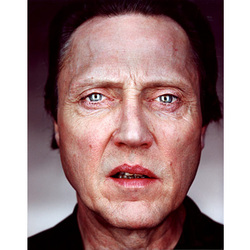
Martin Schoeller s one photographer who came to mind when taking pictures for my 'Being Perfect' mini project. the reason I chose to look at him was because he did a project called 'close up' in which he took close up head shot images of celebrities which was really unflattering. he lit his models from the side and behind to enhance all their features and flaws, this included, bags under the eyes, wrinkles, signs of ageing and bad skin. He links in really well with my project because like him I want to take extreme close-ups of my model and light them from both behind and the side so they look unflattering. I want them to look unflattering because the images are going to be edited to my models perception of what perfect is and how she would change herself to become perfect. The lighting has to be unflattering like Martin Schoeller because I want my models flaws to be as obvious as possible because I want you to be able to see her imperfections.
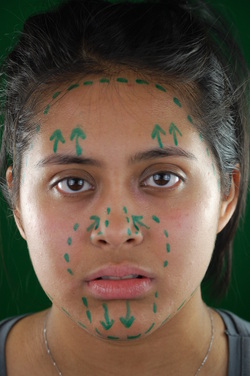
The mental illness shutter speed area of study smoothly lead me to my next project which was looking at perfection. I started to look at what it means to be perfect and what length people go to to achieve to have themselves perfected. This project took me down a path where this was more of an individual exercise as everyone defines 'perfect' in their own ways and how they think being perfect physically would be. To start with I asked my model if she had the chance what would she change about herself. She said that she would firstly raise her left eyebrow so it is as raised and arched like the right eyebrow. She also wanted to improve her hairline by straightening it up, make her nose smaller, elongate her face by lowering her chin and chisel her face to make her face look more structured. To illustrate what the model wanted to change I looked on the internet what surgery markings looked like and them I used that as my guide line and drew on my my models face. I have annotated the picture so it is a visual description of what she wanted to change in case it is unclear in my photograph. I took many photographs like the ones below however I didn't put them up because they were all the same and there was no need to put all of them as they just look like duplicates. These photographs were illustrations of what the model wanted to change but also a before picture so you can compare it to the after pictures. I looked at both what could go well and what could go wrong during surgery. I did this because some people will do anything to reach being perfect which can only be defined by the image in their head and to them that image could be the best possible way to look whereas to others it could be completely wrong. I also did this as surgery could go wrong at any time and this is just one of the many risks people take. This project unlike the shutter speed experimentation involved a lot of Photoshop manipulation as the whole project involved Photoshop as this was the software I used to drastically change the image of my model. I almost wanted this to look like a client profile as the way I chose to take close up head shots which I lit from the sides and the back to make the image appear bright and unflattering to accentuate the flaws.
Analysis
The slide show below documents some of the techniques I used in Photoshop to achieve the plastic surgery look. I first opened up a my image in Photoshop and used the lasso tool to select the right eyebrow and then copied and pasted it. After that I used the clone tool to straighten the hairline and get rid of the baby hairs on her forehead as well as removing both eyebrows as I will be using the new pasted eyebrow. I positioned both the new eyebrows on the forehead so now the eyebrows are identical and symmetrical as they were not before and she now had a straighter and improved hairline. The most important and used tool in this project was the liquify tool to take in her face and give her more definition such as cheek bones and a stronger face structure.I used the pucker tool too decrease the size of her nose. To do this I increased the brush size by a significant amount so that the brush covered the whole nose and then clicked on it twice to make the nose smaller so it was now in proportion with her face. As I have now made her face slimmer her ears appeared to be longer and looked as if they had been stretched out so I used the wrap tool to push her ears up so they looked like they had been pinned up and looked more normal. I used the push tool to give her nostrils the oval shape they had before I touched her nose. Also using the wrap tool I moved left eye so it was as even as possible with the right eye. Finally I used the bloat and pucker tool to adjust her lips and when I was happy with the size I used the wrap tool to bring her lips closer together so it wasn't so stretched across her face.
Surgery Gone Wrong
I have looked at both the negative and positive outcomes of having plastic surgery. The photographs below are Photoshop manipulations to make the model look worse after plastic surgery. I used the same tools as I did when trying to perfect my model but this time I changed the purpose of my manipulation. I didn't want to make the photographs to be too over exaggerated, I wanted to make it look like it was a bad plastic surgeon who operated on her. To create the image of someone who had bad plastic surgery I used the liquify tool but instead of trying to perfect her I made everything look worse by trying to make her look less attractive. The liquify tool was used to make her nose look disproportionate in comparison to the rest of her face. I then used the wrap tool to move her eyebrows so they looked uneven and unsymmetrical.
Emotions
To start with I looked up the definition of emotion. Emotion
1) A natural instinctive state of mind deriving from ones circumstances, or relationships with others.
2)Any of the particular feelings that characterise such a state of mind, such as joy, anger, love, hate etc.
The next step is now to explore different types of emotions as researching about illnesses makes you feel different all the time. There are many emotions linked to many illnesses, so to portray these as correct as possible in my final photographs I need to experiment with making my models feel certain emotions which are linked to the illnesses they will be portraying. This means I will be concentrating on facial expressions as this is the most obvious indication to how someone is feeling. I will also be looking at hand gestures and body movements as this connects to facial expressions. However I will not be taking full body shots for my final piece therefore I only need to focus on the waist and upwards, the face being the most important focus. To accompany the facial expressions and body movement I will also need to dress my models appropriately. I want to dress all my models differently as I will be using their personalities to address them an emotion.
1) A natural instinctive state of mind deriving from ones circumstances, or relationships with others.
2)Any of the particular feelings that characterise such a state of mind, such as joy, anger, love, hate etc.
The next step is now to explore different types of emotions as researching about illnesses makes you feel different all the time. There are many emotions linked to many illnesses, so to portray these as correct as possible in my final photographs I need to experiment with making my models feel certain emotions which are linked to the illnesses they will be portraying. This means I will be concentrating on facial expressions as this is the most obvious indication to how someone is feeling. I will also be looking at hand gestures and body movements as this connects to facial expressions. However I will not be taking full body shots for my final piece therefore I only need to focus on the waist and upwards, the face being the most important focus. To accompany the facial expressions and body movement I will also need to dress my models appropriately. I want to dress all my models differently as I will be using their personalities to address them an emotion.
Experimentation
When I was researching emotions I wanted to create a mini project which would be a short piece of footage illustrating different emotions and facial expressions. The video was done using a camcorder, this is different to many of the other projects I've done because I have never used film before so I thought this would add variety to my work and portfolio. I also took a set of pictures for the same purpose hoping to create a film which contained only still images looking like a moving piece of footage however this did not work but you can still view the footage below.
The Set Up For My Photo Shoot
To do my photo shoots I used a black display board, a tripod, light lamp, and a reflector.
Raw Photographs For My Final Piece
Experimentation & Analysis
Before editing my final picture I experimented with some of my raw photographs to see what the images would look like by applying different effects on them. I have edited each image in Photoshop to exaggerate the colours in the image and to edit out the green room from the background and make it black. I copied the original layer and began to adjust the brightness and contrast and then using the rubber I rubbed out the parts of the image I did not want. I repeatedly did this for each image to create a different effect for separate parts of the image. As each picture has 2 models I edited each one differently to the other going with the theme of dark & light, good & evil. By doing this I wanted to create an image where it showed an unstable state of mind showing both the good and bad side of the mid.When making some parts darker I would increase the contrast and decrease the brightness and then add a blue colour tint. When trying to represent the good side I would increase the brightness and the reds in the image as well as adjusting the reds with the colour balance. After adjusting my model I would use the brush tool and select a brush style with a soft edge and increase the brush size to about 350 and then colour in the background to make it black. The reason I chose black as it represents a sinister, unstable mind which is exactly the look I am going for in my images. I will be implementing these techniques when editing my final photographs for the exam.










